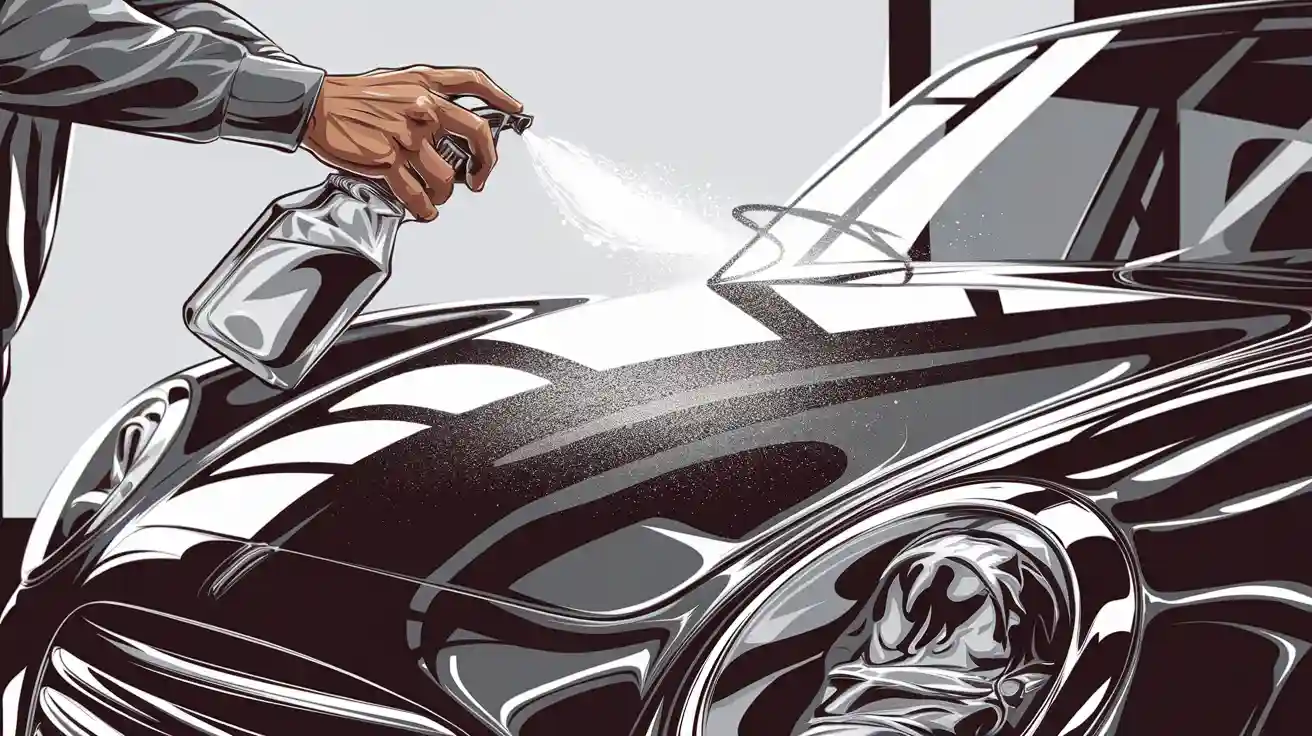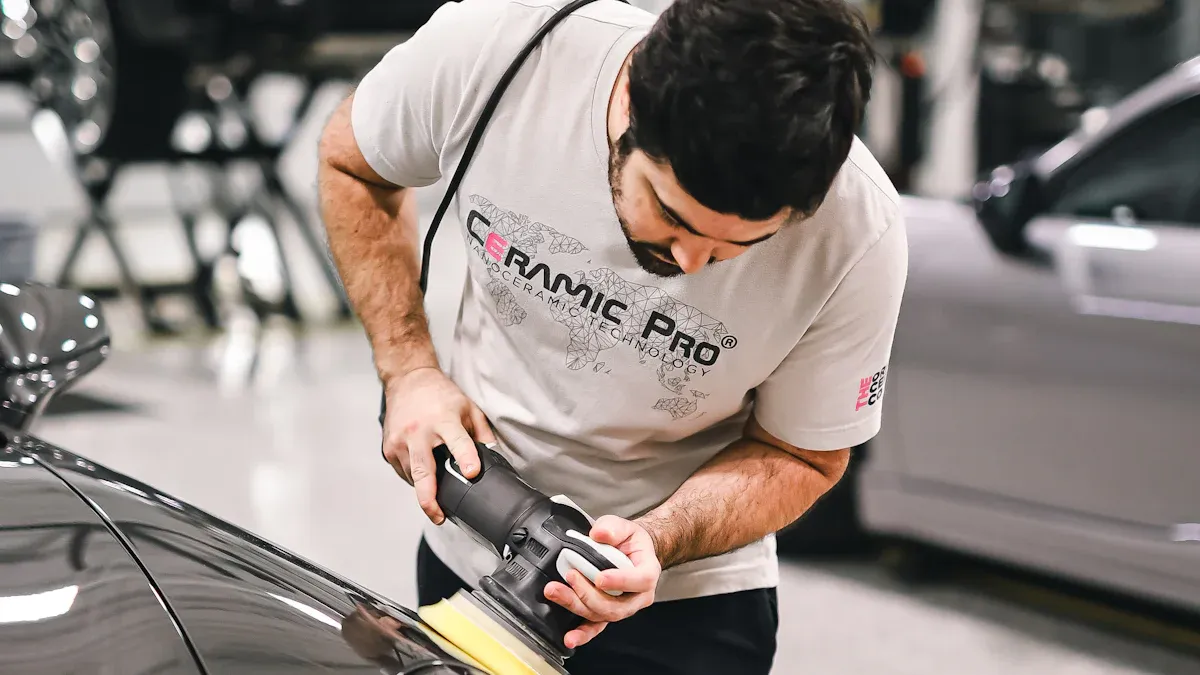
You want your car to shine like new, right? To get the best results, always start with a clean car. Make sure you dry it completely. Grab your car cleaner spray and a soft towel. Using a quick detailing spray makes the process simple. Just spray, wipe, and watch the shine appear. You can clean your car in minutes and feel proud of your detailing skills.
Tip: Never skip drying your car before using car cleaner spray. This step helps you avoid streaks!
Key Takeaways
Always start with a clean, dry car to avoid streaks and get the best shine from your car cleaner spray.
Use fresh microfiber towels for each step to protect your paint and achieve a streak-free finish.
Spray the cleaner lightly and work on one small section at a time for even coverage and a professional look.
Quick detailer sprays clean fast, boost shine, and protect your car’s surface from water, dirt, and sun damage.
Regular use of car cleaner spray and foam cleaner keeps your car shiny, protected, and looking new longer.
Car Cleaner Spray Benefits
Quick Cleaning
You want to clean your car fast, right? Quick detailers make that possible. When you use a car cleaner spray, you save time and effort. The unique formula in these sprays lifts light dirt and dust. You do not need to rinse. Just spray, wipe, and you are done. Here is why quick cleaning works so well:
The spray-and-wipe method lets you clean without water.
Lubricating ingredients protect your paint from scratches.
You get a high-gloss finish in minutes.
The product is portable, so you can use it anywhere.
Customers love it, giving it a 4.8 out of 5 rating for speed and results.
Quick detailers work great between washes. You can keep your car looking fresh every day. Many drivers use quick detailers after a wash or before a big event to get that showroom shine.
Enhanced Shine
You want your car to stand out. Quick detailing spray helps you get that deep, glossy look. When you use a quick detailer, you boost the shine and make your paint pop. Foam cleaner also plays a big role. It lifts away dust and leaves a smooth surface. You can use foam cleaner with a microfiber towel for the best results. Quick detailers and car cleaning foam work together to give your car a mirror-like finish. You will notice the difference right away. Your car will look like it just came from a professional detailing shop.
Surface Protection
You want your car to stay clean and safe. Foam cleaner and car cleaning foam do more than just clean. They add a strong layer of protection. Many quick detailers use advanced formulas, like graphene, to give you superior protection. Take a look at how these products perform:
Performance Metric |
Testing Methodology / Standard |
Result for Adam’s Graphene Spray Coating |
Significance |
|---|---|---|---|
Hydrophobicity |
Contact angle measurement |
Strong water repellency, easy cleaning |
|
Scratch Resistance |
ASTM D5178 standard |
9.2/10 |
High durability against scratches |
Durability |
Exposure to UV, heat, weather |
Rated for 12+ months |
Long-lasting protection |
Gloss Retention |
Environmental exposure tests |
95% retention after 6 months |
Keeps your car shiny longer |
UV and Chemical Resistance |
Lab and real-world tests |
Excellent protection |
Shields paint from sun and chemicals |
Graphene-based sprays and foam cleaner help your car resist water, dirt, and sun damage. You get peace of mind knowing your car has superior protection. With regular use of car cleaning foam and foam cleaner, you keep your car looking new and protected from the elements.
Preparation for Best Results

Wash and Dry First
You want the best cleaning results, so always start with a clean, dry car. Skipping this step can leave behind dirt and water spots that ruin your shine. Here’s why you should never rush the washing and drying process:
Quick washes leave behind dirt and hard water spots that are tough to remove later.
Professional detailers use warm soapy water, special chemicals, and clay bars to perfect a car’s finish.
A final rinse with a drying compound helps you get that ultimate shine.
These steps make sure your quick detailing spray works as it should.
Industry experts agree: washing and drying are key to keeping your car looking great and holding its value.
If you want to know how to use a waterless car wash, remember that it works best on light dust or fingerprints. For heavy dirt, always wash first.
Gather Microfiber Towels
Grab at least three microfiber towels before you start. These towels are soft and safe for your paint. They pick up dirt without scratching. Using high-quality microfiber towels helps you avoid swirl marks and streaks. Always use a fresh towel for each step. One for applying the quick detailer spray, one for buffing, and one for any touch-ups. Never use old or dirty towels, as they can trap grit and scratch your car.
Tip: Wash your microfiber towels separately from other laundry. This keeps them soft and ready for your next waterless car wash.
Choose the Right Spray
Not all sprays are the same. Some work better on interiors, while others shine on paint or glass. Expert reviews show big differences in how sprays clean, smell, and protect. For example, Meguiar’s offers strong UV protection but can struggle with tough stains. Chemical Guys Leather Cleaner Kit gets high marks for easy use and a pleasant scent. When you pick a car cleaner spray, think about what you need most—shine, protection, or stain removal. If you want the best results, try a quick detailer spray made for your car’s surface. Waterless car wash sprays are great for quick touch-ups between washes.
How to Use a Quick Detailer

Spray Technique
You want your car to look its best, so you need to master the spray technique. Start by shaking your quick detailer spray well. Hold the bottle about a foot away from the car’s surface. Spray two or three times on each small section, like a door or a fender. Use a light mist. This helps you cover the area evenly without soaking it. If you spray too much, you might need to buff more, which can waste time.
Professional detailers always work panel by panel. They know that spraying too much or too little can affect the shine. Studies show that a steady, even spray gives you a smooth finish. If you stop and start too often, you might see streaks or uneven spots. Keep your hand moving in a straight line as you spray. This way, you avoid overlapping and missing spots. A good spray technique makes your car look uniform and glossy.
Tip: Spray in a shaded area. Sunlight can dry the product too fast and leave streaks.
Wipe Method
After spraying, grab a clean microfiber towel. Wipe the area using straight lines, either side to side or up and down. Avoid circles. Circular motions can cause swirl marks on your paint. You want a streak-free finish, so use gentle pressure. Let the quick detailer do the work.
Different wiping materials can change your results. Microfiber towels work best because they are soft, lint-free, and absorbent. They pick up dirt and leave no residue. Here’s a quick look at how different materials compare:
Wipe Material |
Characteristics |
Impact on Streak-Free Finish |
|---|---|---|
Polyester |
Lint-free, high absorbency |
Reduces lint, good for streak-free |
Polypropylene |
Non-abrasive, anti-static |
Less likely to scratch or leave marks |
Nylon Microfiber |
High absorbency, low lint |
Best for deep cleaning and no streaks |
Polyurethane Foam |
Most absorbent, non-shedding |
Great for liquid application, no streaks |
Always flip your microfiber towel to a clean side as you wipe. If the towel gets dirty, switch to a fresh one. This keeps dirt from scratching your paint. For the best shine, buff the area lightly after wiping.
Note: If you want to know how to use a waterless car wash, the wiping method is almost the same. Always use a clean towel and gentle strokes.
Section by Section
Work on your car one section at a time. This means you clean and shine each part before moving to the next. Start with the roof, then move to the hood, doors, and so on. This method helps you avoid missing spots or overlapping areas.
Detailing experts use this approach for a reason. When you focus on one section, you can clean every corner and edge. You get better results, especially in tricky spots like door handles and mirrors. Working section by section also lets you spot any stubborn stains or marks. If you find one, you can treat it right away.
Taking your time with each section gives your car a professional look. You do not rush, so you do not leave streaks or water spots. This method also helps protect your paint and keeps your car looking new longer.
Pro Tip: Always check your work in good light. This helps you see any missed spots or streaks before you finish.
Pro Tips for Best Results
Avoid Common Mistakes
You want your car to look its best, so you need to avoid some common mistakes. Many people rush through detailing and end up with streaks or scratches. Always use fresh microfiber towels. Dirty towels can trap grit and scratch your paint. Never use car cleaning foam or foam cleaner on a heavily soiled car. If your car has mud or thick dirt, wash it first. Waterless car wash sprays work best on light dust or fingerprints.
Experts suggest you pay attention to your process. Take your time and check each section as you go. Use a steady spray and wipe gently. If you want to avoid mistakes, follow these tips:
Use a clean towel for each step.
Spray a light mist, not too much.
Work in small sections.
Check your work in good light.
Tip: Quality control matters. Just like experts in studies, you should check your tools and steps to catch any errors early.
Handle Stubborn Stains
Sometimes, you find bug splatters or tar that just will not come off with regular foam cleaner. Do not scrub hard. Instead, use a bug or tar remover before you reach for your car cleaning foam. Spray the remover on the spot, let it sit, and then wipe gently. After that, use your foam cleaner or waterless car wash spray to finish the job. This way, you protect your paint and get a smooth finish.
If you see bird droppings or tree sap, act fast. These stains can damage your paint if left too long. Use a dedicated foam cleaner for these spots. Always follow up with car cleaning foam to keep your car looking fresh.
Maintain Shine
You want that glossy look to last. Regular use of foam cleaner and car cleaning foam helps you keep your car shiny. After each wash, use a waterless car wash spray for quick touch-ups. This keeps dust and fingerprints away. Store your towels in a clean, dry place. Replace them when they get worn out.
Set a schedule for detailing. Many car owners do a full detail every month and use foam cleaner for weekly touch-ups. This routine keeps your car looking new. Remember, the right products and a little care go a long way.
Note: Consistency is key. Just like experts check their data often, you should check your car’s shine and touch up as needed.
You now know how easy it is to make your car shine. Start with a clean, dry surface, use the right spray, and wipe with fresh microfiber towels. Regular detailing keeps your car looking new and protects its value. More people care about car care than ever before. The car detailing market keeps growing because drivers want their vehicles to look great and last longer. Enjoy the shine and take pride in your ride!
FAQ
How often should you use car cleaner spray?
You can use car cleaner spray as often as you like. Many people use it once a week. If your car gets dusty or has fingerprints, a quick spray keeps it looking fresh.
Can you use car cleaner spray on windows?
Yes, you can use most car cleaner sprays on windows. Always check the label first. For a streak-free finish, use a clean microfiber towel and wipe in straight lines.
What is the difference between quick detailer and interior detailer spray?
Quick detailer works best on your car’s exterior. It adds shine and removes light dust. Interior detailer spray is made for inside surfaces like dashboards, seats, and door panels. Use each product where it works best.
Will car cleaner spray remove water spots?
Car cleaner spray can remove light water spots. For tough spots, you may need a special cleaner. Always dry your car after washing to prevent water spots from forming.








0 comments